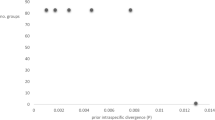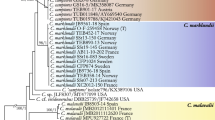Abstract
Known to date only from the Neotropics, the genus Staheliomyces E. Fisch. (Phallaceae, Phallales) was described from Suriname with only a single species, S. cinctus E. Fisch. Nearly 100 years have passed since the original description, and its systematic position and species diversity have not been investigated. Collections from Brazil and Costa Rica were studied, and four new species are described based on morphology, molecular phylogenetic analyses, and nomenclatural review. We provide morphological descriptions together with a key to species, and a proposal to emend the genus. We review the type material of S. cinctus located in herbarium of Botanischer Garten der Universität Bern (BERN), and establish the phylogenetic position of the genus which clusters with Xylophallus (Schltdl.) E. Fisch. in an exclusively neotropical clade. Our results highlight the importance of studying neglected taxa that impacts knowledge of biodiversity especially for localities that have been poorly collected. The study of herbarium collections can reveal data on forgotten type materials and shed light on the work of pioneering mycologists. This study also brings insights into biogeographical diversity of the phalloid fungi.







Similar content being viewed by others
Data availability
The datasets generated in this study can be found in online repositories. The names of the repository/repositories and accession number(s) can be found in the article.
References
Accioly T, Sousa JO, Moreau P-A et al (2019) Hidden fungal diversity from the Neotropics : Geastrum hirsutum, G. schweinitzii (Basidiomycota, Geastrales) and their allies. PLoS One 14:e0211388. https://doi.org/10.1371/journal.pone.0211388
Baseia IG, Maia LC, Calonge (2006) Notes on Phallales in the neotropics. Bol Soc Micol Madr 30:87–93
Beebe W, Hartley GI, Howes PG (1917) Tropical wildlife in British Guiana, v. I. New York Zoological Society, New York
Benson DA, Clark K, Karsch-Mizrachi I et al (2015) GenBank. Nucleic Acids Res 43:D30–D35. https://doi.org/10.1093/nar/gku1216
Brown SDJ, Collins RA, Boyer S et al (2012) Spider: An R package for the analysis of species identity and evolution, with particular reference to DNA barcoding. Mol Ecol Resour 12:562–565. https://doi.org/10.1111/j.1755-0998.2011.03108.x
Burr B, Barthlott W, Westerkamp C (1996) Staheliomyces (Phallales) visited by Trigona (Apidae): melittophily in spore dispersal of an Amazonian stinkhorn? J Trop Ecol 12:441–445
Cabral TS (2020) Staheliomyces in Flora do Brasil 2020 em construção. In: Jard. Botânico do Rio Janeiro. http://floradobrasil.jbrj.gov.br/reflora/floradobrasil/FB95552. Accessed 7 Jan 2021
Cabral TS, da Silva BDB, Ishikawa NK et al (2014) A new species and new records of gasteroid fungi (Basidiomycota) from Central Amazonia, Brazil. Phytotaxa 183:239–253. https://doi.org/10.11646/phytotaxa.183.4.3
Cabral TS, Silva BDB, Martín MP et al (2019) Behind the veil – exploring the diversity in Phallus indusiatus s.l. (Phallomycetidae, Basidiomycota). MycoKeys 58:103–127. https://doi.org/10.3897/mycokeys.58.35324
Calonge FD, Mata M, Carranza J (2005) Contribución al catálogo de los Gasteromycetes (Basidiomycotina, Fungi) de Costa Rica. An del Jardín Botánico Madrid 62:23–45
Cheype J (2010) Phallaceae et Clathrus récoltés en Guyane Française. Bull Mycol Bot Dauphiné-Savoie 197:51–66
Coates R, Velázquez-Narváez C, Campos-Villanueva Á (2017) Macrohongos de la Estación de Biología Tropical “Los Tuxtlas”, Veracruz, México. F Guid F Museum 825:1–6
Crous PW, Wingfield MJ, Burgess TI et al (2018) Fungal planet description sheets: 716–784. Persoonia Mol Phylogeny Evol Fungi 40:240–393
da Silva BDB, Cabral TS, Marinho P et al (2013) Two new species of Geastrum (Geastraceae, Basidiomycota) found in Brazil. Nov Hedwigia 96:445–456. https://doi.org/10.1127/0029-5035/2013/0089
Fischer VE (1921) Mykologische Beiträge 18–20. Staheliomyces cinctus, ein neuer Typus aus der Gruppe der Phalloideen. Mitteilungen der Naturforsch Gesellschaft Bern 137–142
Fischer E (1933a) Gastromyceteae Stahelianae. Ann Mycol 31:113–125
Fischer VE (1933b) Phallinae. In: Engler A, Prantl K (eds) Die natürlichen Pflanzenfamilien nebst ihren Gattungen und wichtigeren Arten insbesondere der Nutzpflanzen, v. 7A. Duncker & Humblot, Berlin, pp 76–108
GBIF (2021) GBIF Occurrence. In: https://doi.org/10.15468/dl.y2ykdg. Accessed 12 Jan 2021
Gube M, Piepenbring M (2009) Preliminary annotated checklist of Gasteromycetes in Panama. Nov Hedwigia 89:519–543. https://doi.org/10.1127/0029-5035/2009/0089-0519
Hartshorn GS, Himmel BE (1994) Vegetation types and floristic patterns. In: McDade LA, Bawa KS, Hespenheide HA, Hartshorn GS (eds) La Selva: Ecology and natural history of a Neotropical rainforest. University of Chicago, pp 73–89
He M, Zhao R, Hyde KD, et al (2019) Notes, outline and divergence times of Basidiomycota. Fungal Divers 4. https://doi.org/10.1007/s13225-019-00435-4
Hoorn C, Wesselingh FP, Steege H et al (2010) Amazonia through time: Andean uplift, climate change, landscape evolution, and biodiversity. Science 330:927–931
Hosaka K (2009) Phylogeography of the genus Pisolithus revisited with some additional taxa from new Caledonia and Japan. Bull Natl Museum Nat Sci Ser B 35:151–167
Hosaka K, Bates ST, Beever RE et al (2006) Molecular phylogenetics of the gomphoid-phalloid fungi with an establishment of the new subclass Phallomycetidae and two new orders. Mycologia 98:949–959. https://doi.org/10.3852/mycologia.98.6.949
Kretzer AM, Bruns TD (1999) Use of atp6 in fungal phylogenetics: an example from the Boletales. Mol Phylogenet Evol 13:483–492
Küppers H (1979) Atlas de los colores. Editorial Blume, Barcelona
Larsson A (2014) AliView: A fast and lightweight alignment viewer and editor for large datasets. Bioinformatics 30:3276–3278. https://doi.org/10.1093/bioinformatics/btu531
Ledo RMD, Colli GR (2017) The historical connections between the Amazon and the Atlantic Forest revisited. J Biogeogr 44:2551–2563. https://doi.org/10.1111/jbi.13049
Leite AG, da Silva BDB, Araújo RS, Baseia IG (2007) Espécies raras de Phallales (Agaricomycetidae, Basidiomycetes) no Nordeste do Brasil. Acta Bot Brasilica 21:119–124
Magnago AC, Trierveiler-Pereira L, Neves M-A (2013) Phallales (Agaricomycetes, Fungi) from the tropical Atlantic Forest of Brazil. J Torrey Bot Soc 140:236–244
Marincowitz S, Coetzee MPA, Wilken PM et al (2015) Phylogenetic placement of Itajahya: an unusual Jacaranda fungal associate. IMA Fungus 6:257–262. https://doi.org/10.5598/imafungus.2015.06.02.01
Melanda GCS, Accioly T, Ferreira RJ et al (2020) Diversity trapped in cages: revision of Blumenavia Möller (Clathraceae, Basidiomycota) reveals three hidden species. PLoS One 15:e0232467. https://doi.org/10.1371/journal.pone.0232467
Melanda GCS, Silva-filho AGS, Lenz AR et al (2021) An overview of 24 years of molecular phylogenetic studies in Phallales (Basidiomycota) with notes on systematics, geographic distribution, lifestyle, and edibility. Front Microbiol 12:689374. https://doi.org/10.3389/fmicb.2021.689374
Miller MA, Pfeiffer W, Schwartz T (2010) Creating the CIPRES science gateway for inference of large phylogenetic trees. In: Proceedings of the Gateway Computing Environments Workshop (GCE). New Orleans, pp 1–8
Nylander JAA (2004) MrModeltest v2. Program distributed by the author
Ovrebo CL, Baroni TJ (1988) Three new species of Rhodocybe from Costa Rica. Mycologia 80:508–514
Paradis E, Schliep K (2019) Ape 5.0: an environment for modern phylogenetics and evolutionary analyses in R. Bioinformatics 35:526–528. https://doi.org/10.1093/bioinformatics/bty633
Reyne A (1955) Ter herinnering aan Prof. Dr. Gerold Stahel. New West Indian Guid / Nieuwe West-Indische Gids 36:1–8. https://doi.org/10.1163/22134360-90000050
Rocabado D, Wright JE, Maillard O, Muchenik NF (2007) Catalogo De Los Gasteromycetes (Fungi: Basidiomycotina) De Bolivia. Kempffiana 3:3–13
Ronquist F, Huelsenbeck JP (2003) MrBayes 3: Bayesian phylogenetic inference under mixed models. Bioinformatics 19:1572–1574. https://doi.org/10.1093/bioinformatics/btg180
Saénz JA, Nassar M (1982) Hongos de Costa Rica: Familias Phallaceae y Clathraceae. Rev Biol Trop 30:41–52
Sánchez-Ramírez S, Etienne RS, Moncalvo JM (2015) High speciation rate at temperate latitudes explains unusual diversity gradients in a clade of ectomycorrhizal fungi. Evolution (N Y) 69:2196–2209. https://doi.org/10.1111/evo.12722
Sobral-Souza T, Lima-Ribeiro MS, Solferini VN (2015) Biogeography of Neotropical Rainforests: past connections between Amazon and Atlantic Forest detected by ecological niche modeling. Evol Ecol 29:643–655. https://doi.org/10.1007/s10682-015-9780-9
Sousa JO, Suz LM, García MA et al (2017) More than one fungus in the pepper pot: integrative taxonomy unmasks hidden species within Myriostoma coliforme (Geastraceae, Basidiomycota). PLoS One 12:e0177873. https://doi.org/10.1371/journal.pone.0177873
Stamatakis A (2014) RAxML version 8: A tool for phylogenetic analysis and post-analysis of large phylogenies. Bioinformatics 30:1312–1313. https://doi.org/10.1093/bioinformatics/btu033
Trierveiler-Pereira L, Meijer A, Silveira R (2019) Phallales (Agaricomycetes, Fungi) from Southern Brazil. Stud Fungi 4:162–184. https://doi.org/10.5943/sif/4/1/19
Trierveiler-Pereira L, Silveira R, Hosaka K (2014) Multigene phylogeny of the Phallales (Phallomycetidae, Agaricomycetes) focusing on some previously unrepresented genera. Mycologia 106:904–911
Trujillo JPG (2009) Introdução à etnomicologia no Equador. Universidade Federal de Pernambuco
Turland NJ, Wiersema JH, Barrie FR et al (2018) International code of nomenclature for algae, fungi, and plants (Shenzhen Code) adopted by the Nineteenth International Botanical Congress Shenzhen, China, July 2017. In: Regnum Vegetabile 159. Koeltz Botanical Books, Glashütten
Vargas-Isla R, Cabral TS, Ishikawa NK (2014) Instruções de coleta de macrofungos : Agaricales e gasteroides. Editora INPA, Manaus
Vilgalys R, Hester M (1990) Rapid genetic identification and mapping of enzymatically amplified ribosomal DNA from several Cryptococcus species. J Bacteriol 172:4238–4246
White TJ, Bruns TD, Lee S, Taylor J (1990) Amplification and direct sequencing of fungal ribosomal RNA genes for phylogenetics. In: Innis MA, Sninsky DH, White TJ (eds) PCR protocols: a guide to methods and applications. Academic Press Inc., New York, pp 315–322
Yanomami HA, Développement I de R pour le, Gardens RB, Ambiental IS (2014) Hwërɨmamotima thë pë ã oni = Manual dos remédios tradicionais Yanomami 131
Zhang J, Kapli P, Pavlidis P, Stamatakis A (2013) A general species delimitation method with applications to phylogenetic placements. Bioinformatics 29:2869–2876. https://doi.org/10.1093/bioinformatics/btt499
Acknowledgments
We thank Dr. Doriane P. Rodrigues for coordination of the Laboratory of Applied Evolution at the Federal University of Amazonas, where part of the molecular data was obtained. We are extremely grateful to Dr. Reinhard Berndt, curator of fungal collection from ETH Zürich, and Dr. Katja Rembold, curator of the herbarium BERN, for providing important information on Fischer’s phalloid fungi collections. We also thank the several people cited in this study who collected and deposited material at herbaria, as well as those who freely provide photos on online databases promoting the development of citizen science. Clark L. Ovrebo thanks the Organization for Tropical studies to allow collecting at the La Selva Research (Biological) Station.
Funding
This work was supported by the Coordenação de Aperfeiçoamento de Pessoal de Nível Superior (CAPES) for NMA (Finance Code 001) and TSC scholarships (88882.317512/2019-01); and by the Conselho Nacional de Desenvolvimento Científico e Tecnológico (CNPq) for GCSM (140541/2018-7) and TSC scholarships (160321/2013-1).
Author information
Authors and Affiliations
Contributions
Material preparation and data collection and analyses were performed by Tiara S. Cabral, Gislaine C.S. Melanda, and Nathalia M. de Assis. The first draft of the manuscript was written by T.S.C., G.C.S.M, and N.M.A, and all authors commented on previous versions of the manuscript. All authors read and approved the final manuscript.
Corresponding author
Ethics declarations
Conflict of interest
The authors declare no competing interests.
Additional information
Section Editor: Zhu-Liang Yang
Publisher’s note
Springer Nature remains neutral with regard to jurisdictional claims in published maps and institutional affiliations.
Rights and permissions
About this article
Cite this article
Cabral, T.S., Melanda, G.C.S., de Assis, N.M. et al. Loosening the belt: unknown diversity of the strangled stinkhorn genus Staheliomyces (Phallales, Basidiomycota). Mycol Progress 21, 46 (2022). https://doi.org/10.1007/s11557-022-01782-4
Received:
Revised:
Accepted:
Published:
DOI: https://doi.org/10.1007/s11557-022-01782-4




